Thermo Fisher Scientific TaqMan GMO Maize Quantification Kit Mode d'emploi
- Taper
- Mode d'emploi

For testing of Food and Environmental samples only.
TaqMan™ GMO Maize Quantification Kit
USER GUIDE
Real-time PCR quantification of GMO maize DNA in food and
feed samples
for use with:
Applied Biosystems™ QuantStudio™ 5 Real‑Time PCR Instrument with Thermo
Scientific™ RapidFinder™ Analysis Software v1.2 or later
Applied Biosystems™ 7500 Fast Real‑Time PCR Instrument with Applied
Biosystems™ RapidFinder™ Express Software v2.0 or later
Catalog Number 4481972
Publication Number MAN0013476
Revision C.0

Oxoid Limited | Wade Road | Basingstoke, Hampshire UK RG24 8PW
For descriptions of symbols on product labels or product documents, go to thermofisher.com/symbols-definition.
The information in this guide is subject to change without notice.
DISCLAIMER: TO THE EXTENT ALLOWED BY LAW, THERMO FISHER SCIENTIFIC INC. AND/OR ITS AFFILIATE(S) WILL NOT BE
LIABLE FOR SPECIAL, INCIDENTAL, INDIRECT, PUNITIVE, MULTIPLE, OR CONSEQUENTIAL DAMAGES IN CONNECTION WITH OR
ARISING FROM THIS DOCUMENT, INCLUDING YOUR USE OF IT.
Revision history: Pub. No. MAN0013476
Revision Date Description
C.0 16 July 2021 •Added Troubleshooting
•Added ISO certification
•Added QuantStudio™ 5 Real‑Time PCR Instrument with Thermo
Scientific™ RapidFinder™ Analysis Software v1.2 or later
B.0 27 July 2020 •Updated “Input DNA requirements” on page 8 to replace the
MagMAX™ instrument with KingFisher™ mL Magnetic Particle
Processor.
•Updated the plate layout example to include duplicate unknown
sample reactions in “Set up the PCR reactions” on page 9.
•Added a footnote in thermal cycler settings table in “Set up and
run the real-time PCR instrument”.
•Added the manufacturing address and limited product warranty
information.
A.0 October 2015 New document. Reformatted Rev. 08-03-2011 from Imegen.
Trademarks: All trademarks are the property of Thermo Fisher Scientific and its subsidiaries unless otherwise specified. TaqMan is a
registered trademark of Roche Molecular Systems, Inc., used under permission and license. Imegen agro is a trademark of Instituto de
Medicina Genómica SL.
©2021 Thermo Fisher Scientific Inc. All rights reserved.

Contents
■CHAPTER 1 Product information .................................................. 5
Product description ............................................................. 5
Principle of the relative quantification procedure .................................... 5
Kit contents and storage ......................................................... 6
Materials required but not provided ................................................ 6
■CHAPTER 2 Methods ............................................................... 8
Input DNA requirements ......................................................... 8
Determine the number of reactions, then thaw the reagents .......................... 8
Prepare a dilution series of the P35S Standard ...................................... 9
Set up the PCR reactions ........................................................ 9
Set up and run the real-time PCR instrument ...................................... 10
Analyze results ................................................................ 11
Test for the presence of inhibitors in the sample .................................... 13
■APPENDIX A Troubleshooting .................................................... 14
■APPENDIX B Supplemental information ........................................ 16
UNE‑EN ISO 9001 certification ................................................... 16
UNE‑EN ISO 14001 certification ................................................. 16
■APPENDIX C Good laboratory practices for PCR .............................. 17
Plate layout suggestions ........................................................ 17
■APPENDIX D Safety ............................................................... 18
Chemical safety ................................................................ 19
Biological hazard safety ......................................................... 20
TaqMan™ GMO Maize Quantification Kit User Guide 3

■APPENDIX E Documentation and support ...................................... 21
Food Safety support ............................................................ 21
Customer and technical support ................................................. 21
Related documentation ......................................................... 22
Limited product warranty ........................................................ 22
Contents
4TaqMan™ GMO Maize Quantification Kit User Guide

Product information
■Product description .................................................................... 5
■Principle of the relative quantification procedure ........................................... 5
■Kit contents and storage ............................................................... 6
■Materials required but not provided ...................................................... 6
IMPORTANT! Before using this product, read and understand the information in the “Safety” appendix
in this document.
Product description
The 35S promoter (P35S) from the cauliflower mosaic virus (CaMV) is used in a large number of
GMO crops, particularly maize. The Thermo Scientific™ TaqMan™ GMO Maize Quantification Kit enables
relative quantification of as little as 0.01% of P35S sequence with respect to total maize in a sample.
The limit of quantification is 20 copies of DNA, and the detection limit of the PCR technique is 3 copies
each of P35S and maize DNA. If the sample contains maize genetic modification (GM) events with
several copies of P35S or another transgenic vegetable species containing P35S, the amount of
transgenic material can be overestimated.
The TaqMan™ GMO Maize Quantification Kit includes:
• Primers and TaqMan™ probes for real-time PCR detection of:
– The P35S promoter
– The endogenous maize gene, MSS
• P35S Standard, a plasmid DNA quantitation standard containing both P35S and MSS targets
• DNA polymerase enzyme and other buer components necessary for real-time PCR
Principle of the relative quantification procedure
1. Two real-time PCR series are performed:
• One detects the P35S promoter.
• One detects the endogenous maize gene, MSS.
• Each PCR series includes a dilution series of the P35S Standard in addition to the unknown
samples and controls.
2. For each sample, P35S and MSS targets are quantified relative to the P35S Standard.
3. The percentage of P35S target with respect to MSS target is then calculated for that sample.
1
TaqMan™ GMO Maize Quantification Kit User Guide 5

Kit contents and storage
Table 1 TaqMan™ GMO Maize Quantification Kit (Cat. No. 4481972)
Component Amount (50 reactions) Storage[1]
P35S Master Mix (blue disc) 375 µL –20°C
Maize Master Mix (red disc) 375 µL –20°C
General Master Mix (white disc) 2 × 625 µL 4°C
P35S Standard (blue cap) 4 × 50 µL –20°C
[1] See the expiration date on the box.
Materials required but not provided
Unless otherwise indicated, all materials are available through the Thermo Fisher Microbiology ordering
process. MLS: Fisher Scientific (fisherscientific.com) or other major laboratory supplier.
Catalog numbers that appear as links open the web pages for those products.
Item Source
Real-time PCR instrument, one of the following:
Applied Biosystems™ QuantStudio™ 5 Real‑Time PCR System
RapidFinder™ Analysis Software v1.2 or later
Contact your local microbiology
sales representative.
Applied Biosystems™ 7500 Fast Real-Time PCR System
RapidFinder™ Express Software v.2.0 or later
Equipment
Adjustable micropipettors (10 µL, 20 µL, 200 µL) Available through the Thermo
Fisher Microbiology ordering
process. See thermofisher.com/
plastics for more information.
Benchtop microcentrifuge with adaptors for PCR plates and/or tubes
Laboratory mixer (Vortex mixer or equivalent)
Optical reaction plates and covers, or optical PCR tubes and caps
MicroAmp™ Fast Optical 96-Well Reaction Plate, 0.1 mL 4346907
MicroAmp™ Optical Adhesive Film, 100 covers 4311971
MicroAmp™ Fast 8-Tube Strip, 0.1 mL
(See below for caps.)
4358293
MicroAmp™ Optical 8-Cap Strips 4323032
Chapter 1 Product information
Kit contents and storage
1
6TaqMan™ GMO Maize Quantification Kit User Guide

(continued)
Item Source
Other plastics and consumables
Aerosol-resistant pipette tips Available through the Thermo
Fisher Microbiology ordering
process. See thermofisher.com/
plastics for more information.
1.5-mL nuclease-free microcentrifuge tubes
Powder-free disposable gloves
Reagents
Nuclease-free water (not DEPC-Treated) AM9938
Recommended kits for DNA isolation, one of the following:
GMO Extraction Kit 4466336
For high-throughput isolation:
Lysis Buer 1 + RNase for Food ID
PrepSEQ™ Nucleic Acid Extraction Kit
A24401
4428176, 4480466
Chapter 1 Product information
Materials required but not provided 1
TaqMan™ GMO Maize Quantification Kit User Guide 7

Methods
■Input DNA requirements ................................................................ 8
■Determine the number of reactions, then thaw the reagents ................................. 8
■Prepare a dilution series of the P35S Standard ............................................ 9
■Set up the PCR reactions ............................................................... 9
■Set up and run the real-time PCR instrument ............................................. 10
■Analyze results ....................................................................... 11
■Test for the presence of inhibitors in the sample .......................................... 13
Input DNA requirements
•Prepare the DNA sample with a method that allows processing of 10–20 g of food sample.
–For low-throughput, manual processing, use the GMO Extraction Kit.
–For high-throughput, automated processing, use Lysis Buer 1 + RNase for Food ID and the
PrepSEQ™ Nucleic Acid Extraction Kit with the KingFisher™ mL Magnetic Particle Processor.
•Prepare at least one mock-purified sample as a negative extraction control, processed with the
same DNA isolation method that is used for test samples.
•Dilute the final DNA sample to 10–25 ng/µL for the PCR.
Determine the number of reactions, then thaw the reagents
1. For each PCR series, plan to include the following reactions (see Figure 2):
•Duplicates for each unknown sample
•Freshly prepared dilution series of the P35S Standard (5 dilutions)
•Negative extraction control (mock-purified samples)
•No-template control reactions (NTC); use nuclease-free water in place of sample DNA
2. Thaw all reagents, vortex to mix thoroughly, then place on ice.
2
8TaqMan™ GMO Maize Quantification Kit User Guide

Prepare a dilution series of the P35S Standard
Prepare 1:10 serial dilutions of the P35S Standard in nuclease-free water, as described in the following
figure.
Standard
2×105 copies
1:10
2×104 copies
1:1000
200 copies
1:100
2×103 copies
1:10000
20 copies
45 µL H2O 45 µL H2O 45 µL H2O45 µL H2O
Vortex
Spin
Vortex
Spin
Vortex
Spin
Vortex
Spin
Vortex
Spin
5 µL 5 µL 5 µL 5 µL
Figure 1 Serial dilution of the P35S Standard
The 1:10 serial dilutions are used to prepare standard curves for P35S and MSS. The number of copies is per 5 µL, or per
PCR reaction.
Set up the PCR reactions
1. Prepare a reaction mix for each PCR series, for the number of reactions required plus 10%
overage.
Component
PCR target
P35S MSS
P35S Master Mix (blue disc) 7.5 µL —
Maize Master Mix (red disc) — 7.5 µL
General Master Mix (white disc) 12.5 µL 12.5 µL
2. Mix thoroughly by vortexing, then distribute 20 µL to the appropriate reaction wells or tubes. See
Figure 2 for an example plate layout.
3. Add 5 µL of each sample DNA (10–25 ng/µL), mock-purified sample (negative extraction control),
or nuclease-free water (no-template control) to the appropriate wells for both P35S and MSS
PCRs.
4. Add 5 µL of each P35S Standard dilution to the appropriate wells for both P35S and MSS PCRs.
5. Seal each plate or tube, mix, then centrifuge briefly to bring the contents to the bottom.
Chapter 2 Methods
Prepare a dilution series of the P35S Standard 2
TaqMan™ GMO Maize Quantification Kit User Guide 9

1 2 3 4
Figure 2 Example plate layout
In this example, each PCR series includes two unknown samples (U) in duplicate and the recommended dilutions of P35S
Standard (S). Negative extraction control (Neg.Ext.; N) and no-template control reactions (NTC; N) are also included.
1Standard dilutions and negative controls, P35S PCR
2Unknown samples, P35S PCR
3Standard dilutions and negative controls, MSS PCR
4Unknown samples, MSS PCR
Set up and run the real-time PCR instrument
See the appropriate instrument user guide for detailed instructions to set up and run the real-time PCR
instrument.
1. Set up the real-time PCR instrument using the following settings:
•Reaction volume: 25 µL
•Passive reference dye: ROX™ dye included
•TaqMan™ probe reporter: FAM™ dye
•TaqMan™ probe quencher: MGB
•Thermal cycler settings:
Setting Stage 1
Enzyme activation
Stage 2
PCR
Number of cycles 1 (Hold) 50
Denature Anneal/extend[1]
Temperature 95°C 95°C 60°C
Time 10 minutes 15 seconds 1 minute
[1] For each PCR cycle, the fluorescence acquisition takes place during the annealing/extension stage.
2. Load the reactions, run the thermal cycler program and collect real-time amplification data.
Chapter 2 Methods
Set up and run the real-time PCR instrument
2
10 TaqMan™ GMO Maize Quantification Kit User Guide

Analyze results
The general process for analyzing results is described in this section. The details of data analysis
depend on the real-time PCR instrument that you use. See the appropriate user guide for instructions
on how to analyze your data.
1. View the amplification plots for all reactions to make sure that they appear normal. See Figure 3
and Figure 4 for example data.
2. Use the Auto instrument setting to set the baseline.
3. Set the FAM™ threshold to 0.1.
4. Confirm that results for the negative controls and P35S Standard are as expected. For unexpected
control results, see Appendix A, “Troubleshooting”.
Sample type P35S PCR series MSS PCR series
Negative extraction
control or no-template
control
No amplification[1] No amplification [1]
P35S Standard dilution
series
Amplification should be detected in all five dilutions for both P35S and MSS
PCR series (see Figure 3).
The standard curves derived from the dilution series should meet the
following requirements (see Figure 4):
• The eciency of the curve should be 86–110% (slope between –3.7
and –3.1).
• The correlation coecient (R2) should be >0.98.
[1] Amplification in a negative control indicates contamination. The assay should be repeated.
5. Determine whether the P35S and MSS targets can be detected and quantified for each unknown
sample.
Table 2 Quantifiability of samples
Unknown sample result Interpretation
No amplification detected. Not detected.
Amplification detected and the sample Ct falls within the
corresponding standard curve.
Detected and quantifiable.
Amplification detected and the sample Ct is greater than the
highest Ct of the corresponding standard curve.
Detected but not quantifiable. The
concentration of DNA in the sample is
too low.
Amplification detected and the sample Ct is lower than the
lowest Ct of the corresponding standard curve.
Detected but not quantifiable. The
concentration of DNA in the sample
is too high. See “Input DNA
requirements” on page 8.
Chapter 2 Methods
Analyze results 2
TaqMan™ GMO Maize Quantification Kit User Guide 11

Table 3 Interpretation of results
MSS PCR P35S PCR Interpretation
Quantifiable Not detected No P35S detected.
Quantifiable Not quantifiable The amount of P35S detected is lower than the limit
of quantification.
Quantifiable Quantifiable The number of copies of P35S with respect to the
number of copies of MSS can be calculated (step 6).
Not quantifiable Not detected No P35S detected and the amount of maize is lower
than the limit of quantification.
Not quantifiable Not quantifiable The amounts of maize and P35S detected are lower
than the limit of quantification.
Not detected Not detected No maize or P35S detected, or inhibitors are present.
See “Test for the presence of inhibitors in the
sample” on page 13.
6. If the results for both PCR series for the unknown samples are quantifiable, calculate the
percentage of P35S as follows:
a. Calculate the number of copies of P35S and MSS using the respective standard curves
(Figure 4).
b. Calculate the percentage of P35S:
% P35S =
x 100
No. of copies of P35S
No. of copies of MSS
Note: Your instrument software may be set up to automatically perform this calculation.
Figure 3 Example amplification curves for P35S Standard dilution series.
Chapter 2 Methods
Analyze results
2
12 TaqMan™ GMO Maize Quantification Kit User Guide

Figure 4 Example standard curves for P35S and MSS targets using P35S Standard dilution series.
Test for the presence of inhibitors in the sample
In this experiment, PCR amplification of the P35S Standard in the presence and absence of a sample
that is suspected of containing PCR inhibitors is compared.
Set up and run two PCRs:
Component Positive control Test
Maize Master Mix (red disc) 7.5 µL 7.5 µL
General Master Mix (white disc) 12.5 µL 12.5 µL
P35S Standard, 1:10 dilution
(4,000 copies/µL)
1 µL 1 µL
Nuclease-free water 5 µL —
Test sample — 5 µL
The sample does not contain inhibitors if the amplification of both PCR reactions is similar.
Chapter 2 Methods
Test for the presence of inhibitors in the sample 2
TaqMan™ GMO Maize Quantification Kit User Guide 13

Troubleshooting
Observation Possible cause Recommended action
In the Positive Control wells,
no target-specific and no IPC
signals are detected.
PCR amplification failure. Check that the thermal cycler settings and
amplification program are correct.
In the negative extraction
control wells, target-specific
and IPC signals are detected.
Contamination during the DNA
extraction procedure.
Contamination may be due to errors in
sample handling, reagent contamination, or
environmental contamination.
•Check that the DNA extraction protocol
was performed correctly.
•Take care to avoid contamination during
sample homogenization: decontaminate
grinding equipment or homogenizer with
10% bleach or DNAZap™ Solutions (Cat.
No. AM9890).
•Decontaminate benchtop surfaces and
other equipment where the DNA
extraction process is performed with
10% bleach or DNAZap™ Solutions.
•If necessary, use fresh reagents and
repeat the DNA extraction.
In the no-template control
wells, target-specific and IPC
signals are detected.
Contamination of the PCR. Contamination may be due to errors in
sample handling, reagent contamination, or
environmental contamination.
•Decontaminate benchtop surfaces and
other equipment where PCR is performed
with 10% bleach or DNAZap™ Solutions
(Cat. No. AM9890).
•Use fresh reagents and repeat the PCR.
•Set up the Positive Control PCR reactions
last to avoid cross-contamination.
In unknown wells, no IPC
signal is detected, but target-
specific signal is detected.
A high copy number of
target DNA exists in samples,
resulting in preferential
amplification of the target-
specific DNA.
No action is required. The result is considered
positive.
In unknown wells, no IPC
or target-specific signal is
detected.
Excess sample DNA in
the PCR; the recommended
maximum is 250 ng.
Repeat the PCR with the correct amount of
DNA. If DNA quantification is not possible,
dilute the DNA sample.
A
14 TaqMan™ GMO Maize Quantification Kit User Guide

Observation Possible cause Recommended action
In unknown wells, no IPC
or target-specific signal is
detected.
(continued)
PCR inhibitors in the sample
DNA.
Repeat the DNA extraction. If the problem
persists, contact Technical Support.
Appendix A Troubleshooting
Test for the presence of inhibitors in the sample A
TaqMan™ GMO Maize Quantification Kit User Guide 15

Supplemental information
UNE‑EN ISO 9001 certification
Imegen is certified against the standard UNE-EN ISO 9001:2015 "Quality management systems" for the
design, development, manufacture, and commercialization of kits for genetic analysis.
UNE‑EN ISO 14001 certification
Imegen is certified against the standard UNE-EN ISO 14001:2015 “Environmental Management
Systems” for the design, development, manufacture, and commercialization of kits for genetic analysis.
B
16 TaqMan™ GMO Maize Quantification Kit User Guide

Good laboratory practices for PCR
To avoid amplicon contamination of samples, follow these guidelines when preparing or handling
samples for PCR amplification:
•Wear clean gloves and a clean lab coat (not previously worn while handling amplified products or
used during sample preparation).
•Change gloves whenever you suspect that they are contaminated.
•Maintain separate areas and dedicated equipment and supplies for:
–Sample preparation and reaction setup.
–Amplification and analysis of products.
•Do not bring amplified products into the reaction setup area.
•Open and close all sample tubes carefully. Avoid splashing or spraying samples.
•Keep reactions and components capped as much as possible.
•Use a positive-displacement pipettor or aerosol-resistant barrier pipette tips.
•Do not open reaction tubes after PCR.
•Do not autoclave reaction tubes after PCR.
•Clean lab benches and equipment periodically with 10% bleach solution or DNAZap™ Solutions
(Cat. No. AM9890). After cleaning with bleach we recommend a rinse with an ethanol solution
because bleach will rust stainless steel.
For additional information, refer to EN ISO 22174:2005 or www.thermofisher.com/us/en/home/life-
science/pcr/real-time-learning-center/real-time-pcr-basics.html.
Plate layout suggestions
•Separate dierent targets by a row if enough space is available.
•Put at least one well between unknown samples and controls if possible.
•Separate negative and positive controls by one well if possible.
•Place replicates of one sample for the same target next to each other.
•Start with the unknown samples and put controls at the end of the row or column.
•Put positive controls in one of the outer rows or columns if possible.
•Consider that caps for PCR tubes come in strips of 8 or 12.
C
TaqMan™ GMO Maize Quantification Kit User Guide 17

Safety
WARNING! GENERAL SAFETY. Using this product in a manner not specified in the user
documentation may result in personal injury or damage to the instrument or device. Ensure that
anyone using this product has received instructions in general safety practices for laboratories and
the safety information provided in this document.
·Before using an instrument or device, read and understand the safety information provided in the
user documentation provided by the manufacturer of the instrument or device.
·Before handling chemicals, read and understand all applicable Safety Data Sheets (SDSs) and use
appropriate personal protective equipment (gloves, gowns, eye protection, and so on). To obtain
SDSs, see the “Documentation and Support” section in this document.
D
18 TaqMan™ GMO Maize Quantification Kit User Guide

Chemical safety
WARNING! GENERAL CHEMICAL HANDLING. To minimize hazards, ensure laboratory personnel
read and practice the general safety guidelines for chemical usage, storage, and waste provided
below. Consult the relevant SDS for specific precautions and instructions:
·Read and understand the Safety Data Sheets (SDSs) provided by the chemical manufacturer
before you store, handle, or work with any chemicals or hazardous materials. To obtain SDSs, see
the "Documentation and Support" section in this document.
·Minimize contact with chemicals. Wear appropriate personal protective equipment when handling
chemicals (for example, safety glasses, gloves, or protective clothing).
·Minimize the inhalation of chemicals. Do not leave chemical containers open. Use only with
sucient ventilation (for example, fume hood).
·Check regularly for chemical leaks or spills. If a leak or spill occurs, follow the manufacturer
cleanup procedures as recommended in the SDS.
·Handle chemical wastes in a fume hood.
·Ensure use of primary and secondary waste containers. (A primary waste container holds the
immediate waste. A secondary container contains spills or leaks from the primary container.
Both containers must be compatible with the waste material and meet federal, state, and local
requirements for container storage.)
·After emptying a waste container, seal it with the cap provided.
·Characterize (by analysis if needed) the waste generated by the particular applications, reagents,
and substrates used in your laboratory.
·Ensure that the waste is stored, transferred, transported, and disposed of according to all local,
state/provincial, and/or national regulations.
·IMPORTANT! Radioactive or biohazardous materials may require special handling, and disposal
limitations may apply.
AVERTISSEMENT ! PRÉCAUTIONS GÉNÉRALES EN CAS DE MANIPULATION DE PRODUITS
CHIMIQUES. Pour minimiser les risques, veiller à ce que le personnel du laboratoire lise attentive‐
ment et mette en œuvre les consignes de sécurité générales relatives à l’utilisation et au stockage
des produits chimiques et à la gestion des déchets qui en découlent, décrites ci-dessous. Consulter
également la FDS appropriée pour connaître les précautions et instructions particulières à respecter :
·Lire et comprendre les fiches de données de sécurité (FDS) fournies par le fabricant avant de
stocker, de manipuler ou d’utiliser les matériaux dangereux ou les produits chimiques. Pour obtenir
les FDS, se reporter à la section « Documentation et support » du présent document.
·Limiter les contacts avec les produits chimiques. Porter des équipements de protection appropriés
lors de la manipulation des produits chimiques (par exemple : lunettes de sûreté, gants ou vête‐
ments de protection).
·Limiter l’inhalation des produits chimiques. Ne pas laisser les récipients de produits chimiques
ouverts. Ils ne doivent être utilisés qu’avec une ventilation adéquate (par exemple, sorbonne).
·Vérifier régulièrement l’absence de fuite ou d’écoulement des produits chimiques. En cas de fuite
ou d’écoulement d’un produit, respecter les directives de nettoyage du fabricant recommandées
dans la FDS.
·Manipuler les déchets chimiques dans une sorbonne.
Appendix D Safety
Chemical safety D
TaqMan™ GMO Maize Quantification Kit User Guide 19

·Veiller à utiliser des récipients à déchets primaire et secondaire. (Le récipient primaire contient les
déchets immédiats, le récipient secondaire contient les fuites et les écoulements du récipient pri‐
maire. Les deux récipients doivent être compatibles avec les matériaux mis au rebut et conformes
aux exigences locales, nationales et communautaires en matière de confinement des récipients.)
·Une fois le récipient à déchets vidé, il doit être refermé hermétiquement avec le couvercle fourni.
·Caractériser (par une analyse si nécessaire) les déchets générés par les applications, les réactifs et
les substrats particuliers utilisés dans le laboratoire.
·Vérifier que les déchets sont convenablement stockés, transférés, transportés et éliminés en res‐
pectant toutes les réglementations locales, nationales et/ou communautaires en vigueur.
·IMPORTANT ! Les matériaux représentant un danger biologique ou radioactif exigent parfois une
manipulation spéciale, et des limitations peuvent s’appliquer à leur élimination.
WARNING! HAZARDOUS WASTE (from instruments). Waste produced by the instrument is
potentially hazardous. Follow the guidelines noted in the preceding General Chemical Handling
warning.
WARNING! 4L Reagent and Waste Bottle Safety. Four-liter reagent and waste bottles can crack
and leak. Each 4-liter bottle should be secured in a low-density polyethylene safety container with the
cover fastened and the handles locked in the upright position.
Biological hazard safety
WARNING! Potential Biohazard. Depending on the samples used on this instrument, the surface
may be considered a biohazard. Use appropriate decontamination methods when working with
biohazards.
WARNING! BIOHAZARD. Biological samples such as tissues, body fluids, infectious agents,
and blood of humans and other animals have the potential to transmit infectious diseases.
Conduct all work in properly equipped facilities with the appropriate safety equipment (for example,
physical containment devices). Safety equipment can also include items for personal protection,
such as gloves, coats, gowns, shoe covers, boots, respirators, face shields, safety glasses, or
goggles. Individuals should be trained according to applicable regulatory and company/ institution
requirements before working with potentially biohazardous materials. Follow all applicable local,
state/provincial, and/or national regulations. The following references provide general guidelines when
handling biological samples in laboratory environment.
·U.S. Department of Health and Human Services, Biosafety in Microbiological and Biomedical
Laboratories (BMBL), 6th Edition, HHS Publication No. (CDC) 300859, Revised June 2020
https://www.cdc.gov/labs/pdf/CDC-BiosafetymicrobiologicalBiomedicalLaboratories-2020-
P.pdf
·Laboratory biosafety manual, fourth edition. Geneva: World Health Organization; 2020 (Laboratory
biosafety manual, fourth edition and associated monographs)
www.who.int/publications/i/item/9789240011311
Appendix D Safety
Biological hazard safety
D
20 TaqMan™ GMO Maize Quantification Kit User Guide
La page est en cours de chargement...
La page est en cours de chargement...
La page est en cours de chargement...
La page est en cours de chargement...
-
 1
1
-
 2
2
-
 3
3
-
 4
4
-
 5
5
-
 6
6
-
 7
7
-
 8
8
-
 9
9
-
 10
10
-
 11
11
-
 12
12
-
 13
13
-
 14
14
-
 15
15
-
 16
16
-
 17
17
-
 18
18
-
 19
19
-
 20
20
-
 21
21
-
 22
22
-
 23
23
-
 24
24
Thermo Fisher Scientific TaqMan GMO Maize Quantification Kit Mode d'emploi
- Taper
- Mode d'emploi
dans d''autres langues
Documents connexes
-
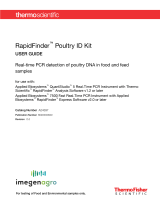 Thermo Fisher Scientific RapidFinder Poultry ID Kit Mode d'emploi
Thermo Fisher Scientific RapidFinder Poultry ID Kit Mode d'emploi
-
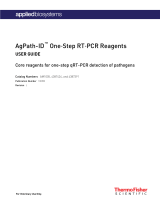 Thermo Fisher Scientific AgPath-ID One Step RT PCR Reagents Mode d'emploi
Thermo Fisher Scientific AgPath-ID One Step RT PCR Reagents Mode d'emploi
-
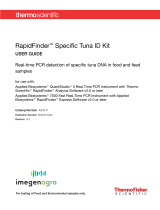 Thermo Fisher Scientific RapidFinder Specific Tuna ID Kit Mode d'emploi
Thermo Fisher Scientific RapidFinder Specific Tuna ID Kit Mode d'emploi
-
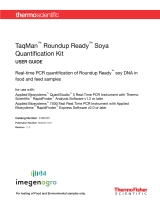 Thermo Fisher Scientific TaqMan Roundup Ready Soya Quantification Kit Mode d'emploi
Thermo Fisher Scientific TaqMan Roundup Ready Soya Quantification Kit Mode d'emploi
-
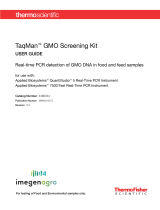 Thermo Fisher Scientific TaqMan GMO Screening Kit Mode d'emploi
Thermo Fisher Scientific TaqMan GMO Screening Kit Mode d'emploi
-
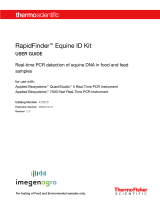 Thermo Fisher Scientific RapidFinder Equine ID Kit Mode d'emploi
Thermo Fisher Scientific RapidFinder Equine ID Kit Mode d'emploi
-
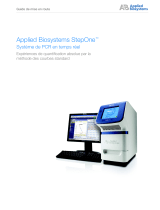 Thermo Fisher Scientific Applied Biosystems StepOne™ Système Le manuel du propriétaire
Thermo Fisher Scientific Applied Biosystems StepOne™ Système Le manuel du propriétaire
-
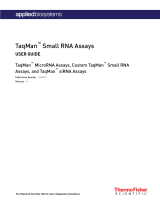 Thermo Fisher Scientific TaqMan Small RNA Assays Mode d'emploi
Thermo Fisher Scientific TaqMan Small RNA Assays Mode d'emploi
-
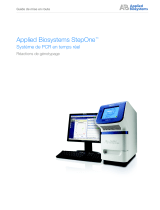 Thermo Fisher Scientific Applied Biosystems StepOne™ Système Le manuel du propriétaire
Thermo Fisher Scientific Applied Biosystems StepOne™ Système Le manuel du propriétaire
-
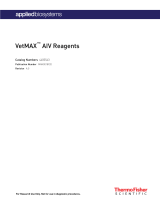 Thermo Fisher Scientific VetMAX AIV Reagents Mode d'emploi
Thermo Fisher Scientific VetMAX AIV Reagents Mode d'emploi

































